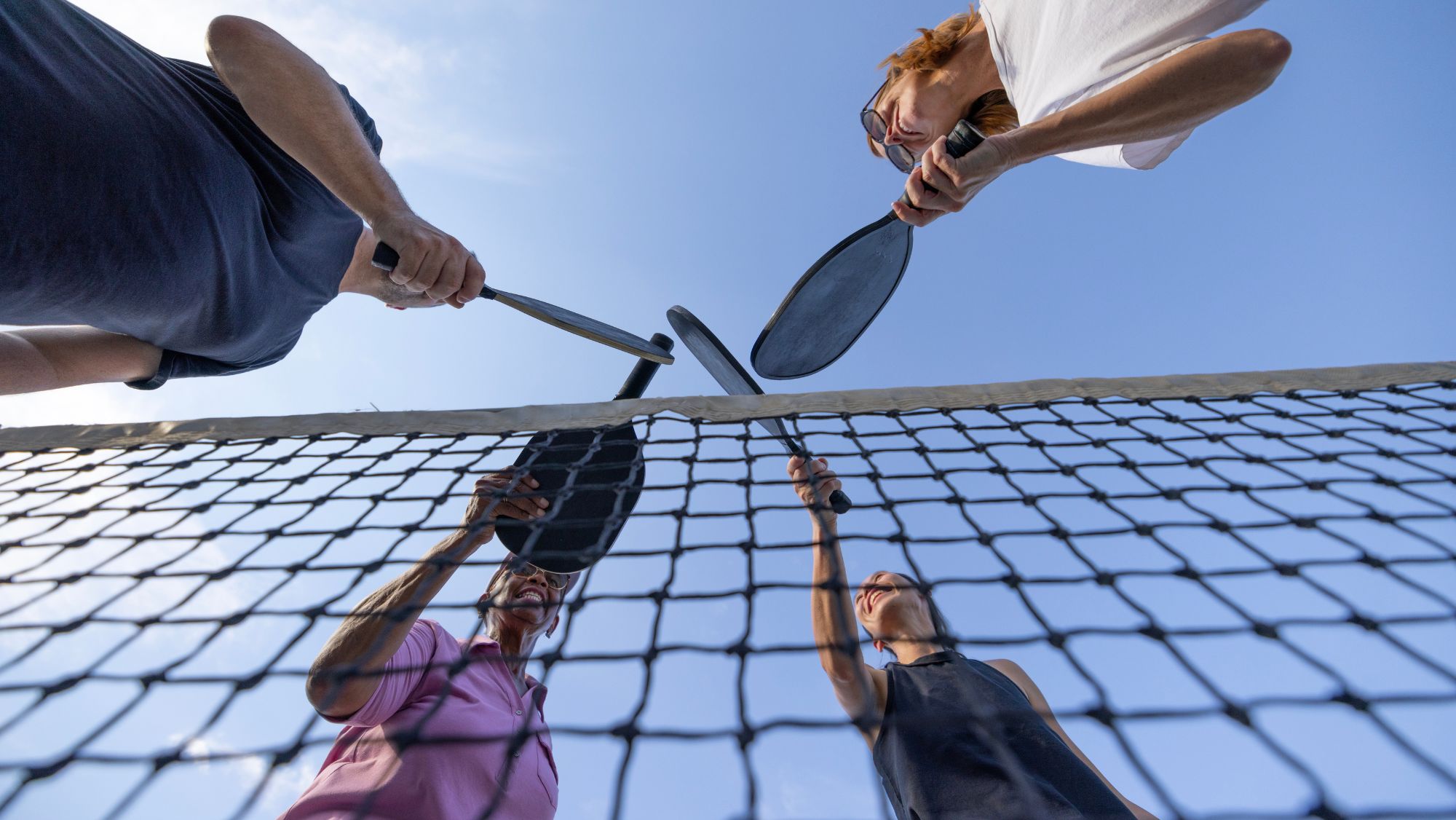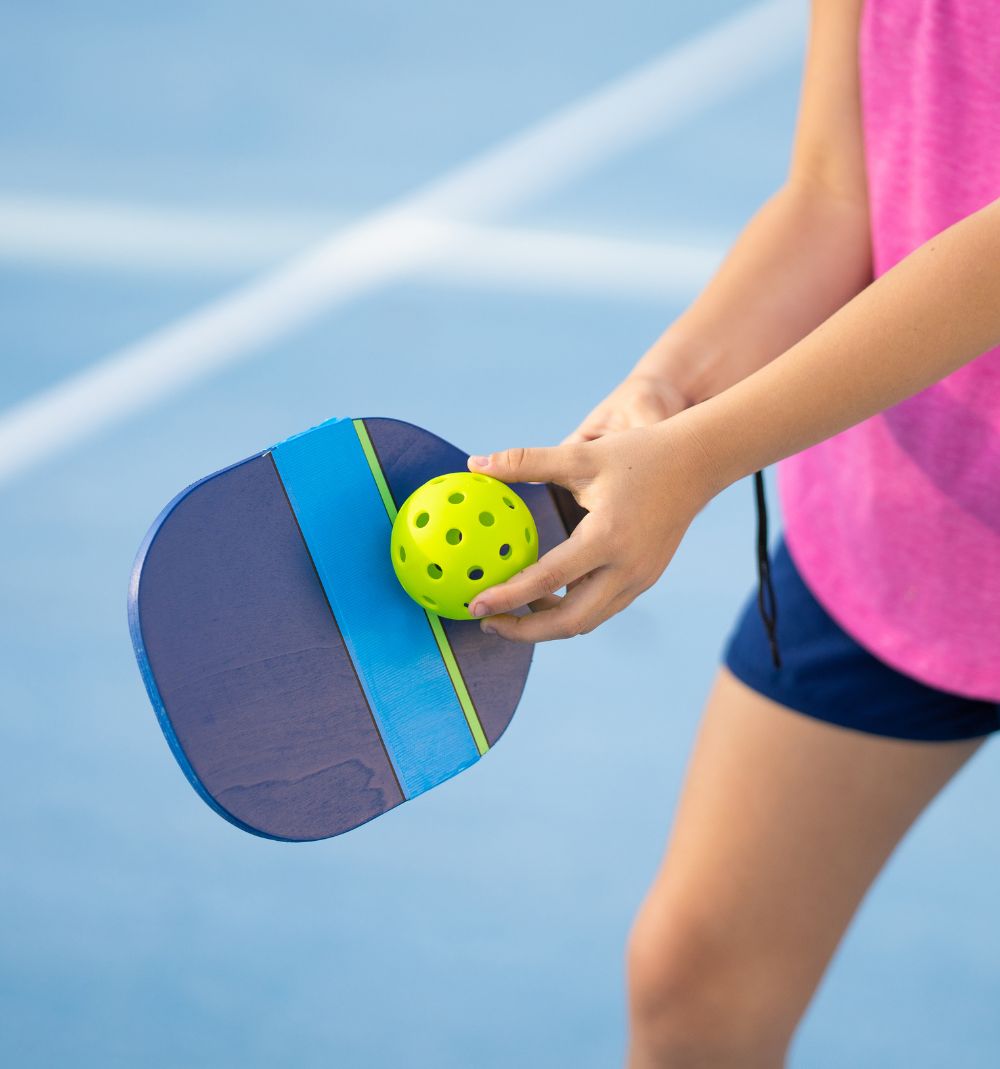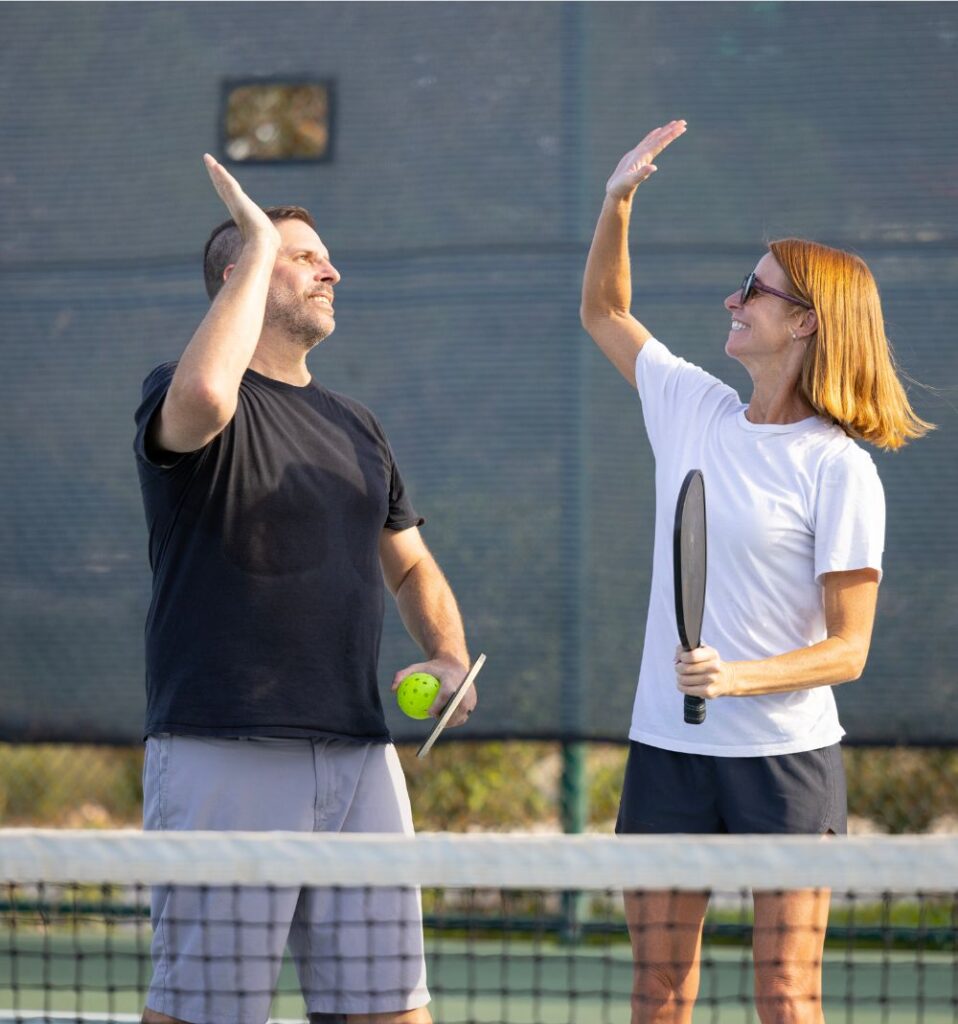
Pickleball is becoming one of the most popular sports in the UK, offering players an exciting mix of tennis, badminton, and table tennis. Whether you’re a beginner or need a quick refresher, understanding the basic rules is key to playing pickleball correctly while having fun.
In this guide, we’ll cover the most essential rules, highlight faults to avoid, and look at the layout of a standard pickleball court, helping you play with confidence.
Ready to play pickleball? Book a class or hire a pickleball court at Bluecoat Sports Health & Fitness Club. For more information about our racket sports or becoming a member, contact us today.
Overview of pickleball rules
The basic rules
The pickleball rules are straightforward, making the game easy for beginners to pick up. It can be played in singles or doubles formats, with many players preferring doubles for its social interaction and added strategy.
The basic rules include:
- Games are typically played to 11 points and must be won by 2 points.
- Only the serving team can score points.
- The double bounce rule (also known as the two-bounce rule) requires the ball to bounce once on each side before any volleys.
- The serve must be underhand and made diagonally into the opposite diagonal court.
- Each server is allowed one serve attempt per rally, unless there’s a let, in which case the serve is replayed. If a fault occurs, the server loses the serve (except in doubles, where the second server then plays).
- A fair method determines which team serves first, like a coin toss. Players should agree on the method to ensure a neutral start to the match.
In singles, each player is responsible for serving and receiving. In contrast, doubles introduces a shared rhythm: teammates alternate serving and receiving based on the score. The server’s position is also dictated by their team’s score. If it’s even, the serve is made from the right side of the court; if it’s odd, from the left. This rule helps ensure balanced court coverage and a consistent rotation of play.
Serving rules and sequence
Serving is where much of the game’s structure takes shape. Here’s how the first serve and subsequent service sequence work:
- The server initiates the point by hitting the ball underhand and below the waist.
- The serve must be made behind the baseline, with at least one foot on the ground.
- The ball must land in the service court diagonally opposite.
- Only one serve attempt is allowed per rally unless a let (a legal serve touching the pickleball net and landing in the correct service box) occurs, in which case the serve is replayed.
In pickleball doubles, both partners serve before the serve goes to the opposing team, except during the first service sequence, where only one partner (the first server) serves. The server switches sides after each point scored and continues serving until a fault is committed.

With each point scored, the server switches sides, while their partner stays in position. This rotation helps maintain balanced court coverage. Remember, the serve must not touch the non-volley zone line, or it will be considered a fault.
Player positioning and court rotation
Positioning works differently in singles and pickleball doubles. In singles, the player covers the whole court alone, switching sides based on their score – right for even, left for odd.
In doubles, teammates share the court. The first server always starts on the right side, with both players standing behind the baseline until the serve. After a point is won, only the server switches sides, while the partner stays in place. Once the first server faults, the second server takes over, unless it’s the first service turn of the game, where only one server is used.
This structured rotation helps maintain court balance and teamwork throughout the match.
The two-bounce rule and the non-volley zone
One of the most important early-game mechanics is the two-bounce rule, which ensures fairness and keeps rallies going. As mentioned earlier, the receiving team must let the ball bounce once before hitting it, and the serving team must then also let it bounce before returning. After these required bounces, players are free to volley – hitting the ball out of the air – provided they are not inside the non-volley zone.
This non-volley zone, often called the kitchen, stretches 7 feet from the pickleball net on each side. Players cannot volley the ball if they are inside the non-volley zone or if any part of their body is touching the non-volley zone line. This rule is designed to discourage overly aggressive net play, ensuring the game remains tactical, inclusive, and accessible to players of all levels.
Faults and common rule violations
A fault in pickleball is any rule violation that stops play. Depending on who commits it, a fault results in either a loss of serve or a point awarded to the opposing team.
Here are some of the most frequent rule violations that count as faults:
- Volleying the ball while standing in the non-volley zone or touching the non-volley zone line
- Serve contacting the non-volley zone line
- Failing to let the ball bounce after the serve, breaking the double-bounce rule
- Incorrect service sequence or wrong player serving in pickleball doubles
- Failing to switch sides correctly after each point scored by the serving team
- Touching the net or crossing over into the opponent’s space before the ball has crossed the pickleball net
- Hitting the ball out of bounds or letting it bounce twice on your team’s court
- The ball contacts anything other than the paddle during a legal return
- Not keeping the server’s feet behind the baseline during the serve
Most of these faults are enforced in casual and competitive play, although enforcement may be more relaxed in social games.
Quick reference: basic pickleball rules
Here’s a quick reference table of the key basic rules:
| Rule | Description |
| Game format | Games are played to 11 points and must be won by 2 points. |
| Scoring | Only the serving team can score points. |
| Serve | Must be underhand, struck below the waist, and land diagonally in the opponent’s service box. |
| Serve attempts | Players are allowed one serve attempt per rally (unless a let occurs). |
| Serving sequence (Doubles) | In pickleball doubles, both partners serve before the serve switches to the opposing team, except during the first service turn. |
| Server’s positioning | The server switches sides after each point won: serve from the right if the score is even, left if odd. |
| First serve | A fair method, such as a coin toss, decides which team serves first. |
| Double-bounce rule | Also known as the two-bounce rule: the ball must bounce once on each side before any volleys. |
| Non-volley zone | Players cannot volley while inside or touching the non-volley zone line; this area extends 7 feet from the net on both sides. |
| Faults | A fault is a rule violation that stops play and results in a loss of serve or a point for the opponent. Common faults include serving into the net, volleying in the non-volley zone, or hitting the ball out of bounds. |
Find out more about How To Start Playing Pickleball with our guide.
How to score in pickleball
Understanding how to keep score in pickleball, especially in pickleball doubles, can seem tricky initially, but it becomes second nature with practice.

Let’s review how scoring works in practice, particularly in pickleball doubles:
- Only the serving team can score points.
- The server’s score is announced first, then the opposing team’s score, followed by whether it’s the first or second server (in doubles).
- If the server loses a rally, the next serve goes to the partner or to the receiving team, depending on the sequence.
The serving doubles team continues serving – switching sides – as long as they continue scoring. Once both players have lost a rally, the serve transfers to the opposing team.
An example call might be: “4-2-1” (4 points for the serving team, 2 for the receiving team, first server). The “1” indicates it’s the first server on the serving team; once they lose the rally, the second server (if applicable) will take over before the serve switches sides.
Pickleball court dimensions
A standard pickleball court, used for singles and doubles play, measures 20 feet wide by 44 feet long – the same size as a regulation doubles badminton court. The same dimensions are used for both singles and doubles, which helps keep the game simple and consistent.
Here are the key areas of the court:
- Non-volley zone: Extends 7 feet from the net on each side.
- Service boxes: Two per side, separated by the centreline.
- Baseline and sidelines: Mark the outer boundaries of the court.
Many clubs create pickleball courts by marking lines on existing tennis courts, as one tennis court can often accommodate multiple pickleball courts. At Bluecoat Sports, we offer pickleball courts with clearly defined lines, so you can focus on your game and make accurate in or out calls with total confidence.
Book a class or hire a pickleball court at Bluecoat Sports
Learning the rules of pickleball gives you a strong foundation to enjoy the game, and knowing the pickleball court dimensions, service rules, and double-bounce rule makes the experience more rewarding.
Pickleball continues to grow thanks to its accessibility, fast pace, and social nature. As you improve, you’ll gain a better understanding of positioning, when to hit the ball, how to manage the serve and volley advantage, and how to communicate effectively with your partner in pickleball doubles.
Join our friendly social pickleball sessions at Bluecoat Sports, open to players aged 14+, every Monday and Friday. Check our class timetable and come along.